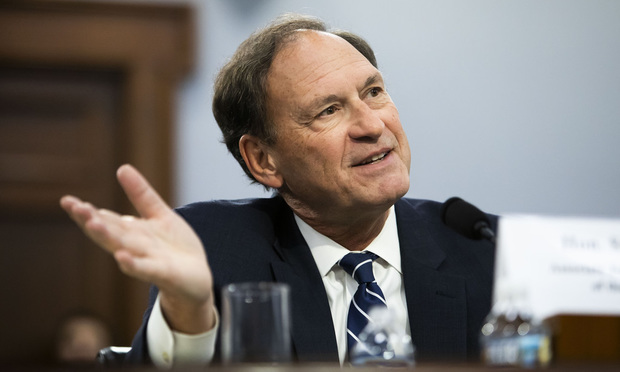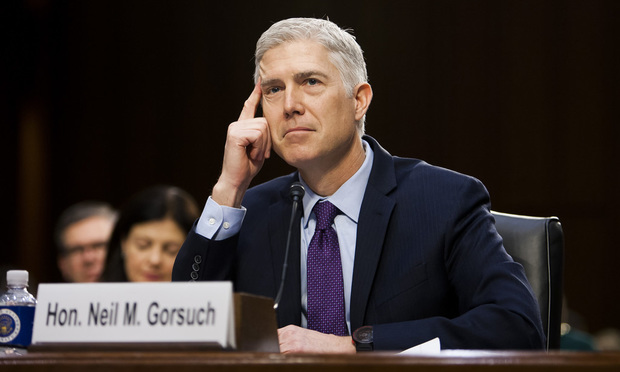Justices Sharply Fracture Over When to Overturn Precedent
Justice Samuel Alito Jr.'s dissent began with his statement that "the doctrine of stare decisis gets rough treatment in today's decision."
April 20, 2020 at 03:17 PM
7 minute read
 Justice Samuel Alito Jr. testifying before Congress in 2019. Credit: Diego M. Radzinschi / ALM
Justice Samuel Alito Jr. testifying before Congress in 2019. Credit: Diego M. Radzinschi / ALM
The U.S. Supreme Court on Monday did more than rule that the Sixth Amendment requires unanimous jury verdicts in state court criminal trials. In highly fractured opinions, the justices appeared to lay down markers on their future willingness to stand by divisive prior decisions, such as the landmark Roe v. Wade abortion ruling.
The justices's 6-3 decision in Ramos v. Louisiana provoked five separate opinions, with unusual lineups, focused primarily on whether to abide by so-called stare decisis—adherence to precedent—or to overrule the 1972 precedent in the case Apodaca v. Oregon, which allowed nonunanimous verdicts in felony criminal trials.
Justice Elena Kagan broke with her colleagues on the court's left to join Chief Justice John Roberts Jr. in signing onto the sole dissent by Justice Samuel Alito Jr. But Alito's dissent, heavily focused on stare decisis, went a step too far for Kagan in one important respect, keeping her from joining his opinion in full.
Justice Neil Gorsuch, who led the six-justice majority, lost Justices Clarence Thomas, Sonia Sotomayor and Brett Kavanaugh in a portion of his opinion that stated the Apodaca opinion had no "precedential force" because a single justice's view controlled that 4-1-4 decision.
Stare decisis—to stand by precedent—is not a rare issue in Supreme Court cases, but it is a flash point at times. This term, in another Louisiana case awaiting a decision—June Medical Services v. Russo—the justices will decide whether to apply, distinguish, narrow, or overrule their 2016 ruling in a nearly identical abortion-related case, Whole Woman's Health v. Hellerstedt.
The separate opinions in the jury case, with their focus on stare decisis, raise the question, "is the majority's opinion principally about unanimous juries or building a foundation for cases to come?" said former federal prosecutor John Marti, a partner at Dorsey & Whitney.
Gorsuch and Kavanaugh, he noted, were questioned closely in their Senate confirmation hearings about the future of Roe v. Wade. "Today, Justice Gorsuch noted 'it is something else entirely to perpetuate something we all know to be wrong only because we fear the consequences of being right.' Perhaps in this opinion, President Trump's appointees are foreshadowing the future reconsideration of Roe."
 Neil Gorsuch testifies at his confirmation hearing in March 2017. Credit: Diego M. Radzinschi/ NLJ
Neil Gorsuch testifies at his confirmation hearing in March 2017. Credit: Diego M. Radzinschi/ NLJIn Monday's decision, Gorsuch called the Apodaca ruling an "admittedly mistaken" constitutional decision and "an outlier" from the start. "In arguing otherwise, the dissent must elide the reliance the American people place in their constitutionally protected liberties, overplay the competing interests of two States, count some of those interests twice, and make no small amount of new precedent all its own," Gorsuch wrote.
Kavanaugh, in an 18-page concurring opinion that elaborated on his view of stare decisis, said he would collapse into three broad categories the seven "somewhat elastic" factors that the court has used to determine whether to overrule precedents.
He wrote that he would ask: Is the prior decision grievously or egregiously wrong? Has the prior decision caused significant negative jurisprudential or real-world consequences? And, would overruling the prior decision unduly upset reliance interests?
In analyzing Apodaca in light of those three questions, Kavanaugh answered yes to all three.
 U.S. Supreme Court Justice Sonia Sotomayor. Credit: Diego M. Radzinschi/ National Law Journal.
U.S. Supreme Court Justice Sonia Sotomayor. Credit: Diego M. Radzinschi/ National Law Journal.Sotomayor's approach to stare decisis in this case rested primarily on two key factors. She wrote that the force of stare decisis is "at its nadir" in cases involving criminal procedure rules. "While overruling precedent must be rare, this Court should not shy away from correcting its errors where the right to avoid imprisonment pursuant to unconstitutional procedures hangs in the balance," she wrote. Evangelisto Ramos was sentenced to life without parole after a nonunanimous jury conviction.
Sotomayor also looked to the legacy of racism that spurred the nonunanimous jury laws of Louisiana and Oregon and those two states' only recent efforts to address the laws' discriminatory purpose and effects by repealing them.
Justice Clarence Thomas, concurring in the judgment, reiterated his long-standing view that the Constitution's privileges and immunities clause is the proper channel for incorporating Bill of Rights guarantees to the states.
"I would simply hold that, because all of the opinions in Apodaca addressed the Due Process Clause, its Fourteenth Amendment ruling does not bind us because the proper question here is the scope of the Privileges or Immunities Clause," Thomas wrote. "I cannot understand why the court, having decided to abandon Apodaca, refuses to correctly root its holding in the Privileges or Immunities Clause."
Alito's dissent began with his statement that "the doctrine of stare decisis gets rough treatment in today's decision. Lowering the bar for overruling our precedents, a badly fractured majority casts aside an important and long-established decision with little regard for the enormous reliance the decision has engendered."
The reliance on Apodaca, which Alito called "massive and concrete," was the central focus of his dissent and he warned that Louisiana and Oregon would face "a tsunami" of litigation on the jury unanimity issue.
But where he lost Kagan was in the part of his opinion in which he claimed that "reliance in this case far outstrips that asserted in recent cases in which past precedents were overruled." Alito then named a long list of those cases, including decisions in which Kagan had dissented, notably the 2018 union fee case, Janus v. AFSCME, overruling a four-decade-old unanimous precedent and last year's decision in Knick v. Township of Scott. Kagan did not write separately in the jury case. Alito wrote the 5-4 majority opinion in Janus.
Alito concluded his dissent with, perhaps, a warning to his colleagues. "By striking down a precedent upon which there has been massive and entirely reasonable reliance, the majority sets an important precedent about stare decisis," he wrote. "I assume that those in the majority will apply the same standard in future cases."
The reliance of generations of women on the right to abortion is often used as an argument against overturning Roe and Planned Parenthood v. Casey.
Former federal prosecutor Harry Sandick, a partner at Patterson Belknap Webb & Tyler, agreed with Dorsey's Marti that the "real debate" in the jury decision is about treatment of stare decisis.
"Is stare decisis for 'suckers,' as a popular Supreme Court podcast says partly in jest, to be used by whichever side finds that the doctrine supports the outcome that they prefer?" asked Sandick in a statement. "Or is it something that has real weight in how a particular case turns out? These are important questions that relate to the public's perception of the legitimacy of the Court's decisions in a host of cases that implicate some of the most contested issues in our society, and at a time when the court's selection has been more influenced by constitutional hardball and political gamesmanship than ever before."
Read more:
'A Very Bad Sign for November': Supreme Court Is Assailed for Wisconsin Ballot Ruling
Sotomayor, Bowing to Futility: 'I Will Cease Noting My Dissent' in Sentencing Dispute
What Alito, Alone, Found 'Amazing' at Abortion Clinic Arguments
Justices Scrutinize Power of Precedent in Major Abortion Rights Argument
Breyer Denounces Ruling That Strikes Precedent, Questions Which Cases Are Next
This content has been archived. It is available through our partners, LexisNexis® and Bloomberg Law.
To view this content, please continue to their sites.
Not a Lexis Subscriber?
Subscribe Now
Not a Bloomberg Law Subscriber?
Subscribe Now
NOT FOR REPRINT
© 2025 ALM Global, LLC, All Rights Reserved. Request academic re-use from www.copyright.com. All other uses, submit a request to [email protected]. For more information visit Asset & Logo Licensing.
You Might Like
View All
'Religious Discrimination'?: 4th Circuit Revives Challenge to Employer Vaccine Mandate
2 minute read
4th Circuit Revives Racial Harassment Lawsuit Against North Carolina School District
3 minute read

DOJ, 10 State AGs File Amended Antitrust Complaint Against RealPage and Big Landlords
4 minute readLaw Firms Mentioned
Trending Stories
- 1'A Death Sentence for TikTok'?: Litigators and Experts Weigh Impact of Potential Ban on Creators and Data Privacy
- 2Bribery Case Against Former Lt. Gov. Brian Benjamin Is Dropped
- 3‘Extremely Disturbing’: AI Firms Face Class Action by ‘Taskers’ Exposed to Traumatic Content
- 4State Appeals Court Revives BraunHagey Lawsuit Alleging $4.2M Unlawful Wire to China
- 5Invoking Trump, AG Bonta Reminds Lawyers of Duties to Noncitizens in Plea Dealing
Who Got The Work
J. Brugh Lower of Gibbons has entered an appearance for industrial equipment supplier Devco Corporation in a pending trademark infringement lawsuit. The suit, accusing the defendant of selling knock-off Graco products, was filed Dec. 18 in New Jersey District Court by Rivkin Radler on behalf of Graco Inc. and Graco Minnesota. The case, assigned to U.S. District Judge Zahid N. Quraishi, is 3:24-cv-11294, Graco Inc. et al v. Devco Corporation.
Who Got The Work
Rebecca Maller-Stein and Kent A. Yalowitz of Arnold & Porter Kaye Scholer have entered their appearances for Hanaco Venture Capital and its executives, Lior Prosor and David Frankel, in a pending securities lawsuit. The action, filed on Dec. 24 in New York Southern District Court by Zell, Aron & Co. on behalf of Goldeneye Advisors, accuses the defendants of negligently and fraudulently managing the plaintiff's $1 million investment. The case, assigned to U.S. District Judge Vernon S. Broderick, is 1:24-cv-09918, Goldeneye Advisors, LLC v. Hanaco Venture Capital, Ltd. et al.
Who Got The Work
Attorneys from A&O Shearman has stepped in as defense counsel for Toronto-Dominion Bank and other defendants in a pending securities class action. The suit, filed Dec. 11 in New York Southern District Court by Bleichmar Fonti & Auld, accuses the defendants of concealing the bank's 'pervasive' deficiencies in regards to its compliance with the Bank Secrecy Act and the quality of its anti-money laundering controls. The case, assigned to U.S. District Judge Arun Subramanian, is 1:24-cv-09445, Gonzalez v. The Toronto-Dominion Bank et al.
Who Got The Work
Crown Castle International, a Pennsylvania company providing shared communications infrastructure, has turned to Luke D. Wolf of Gordon Rees Scully Mansukhani to fend off a pending breach-of-contract lawsuit. The court action, filed Nov. 25 in Michigan Eastern District Court by Hooper Hathaway PC on behalf of The Town Residences LLC, accuses Crown Castle of failing to transfer approximately $30,000 in utility payments from T-Mobile in breach of a roof-top lease and assignment agreement. The case, assigned to U.S. District Judge Susan K. Declercq, is 2:24-cv-13131, The Town Residences LLC v. T-Mobile US, Inc. et al.
Who Got The Work
Wilfred P. Coronato and Daniel M. Schwartz of McCarter & English have stepped in as defense counsel to Electrolux Home Products Inc. in a pending product liability lawsuit. The court action, filed Nov. 26 in New York Eastern District Court by Poulos Lopiccolo PC and Nagel Rice LLP on behalf of David Stern, alleges that the defendant's refrigerators’ drawers and shelving repeatedly break and fall apart within months after purchase. The case, assigned to U.S. District Judge Joan M. Azrack, is 2:24-cv-08204, Stern v. Electrolux Home Products, Inc.
Featured Firms
Law Offices of Gary Martin Hays & Associates, P.C.
(470) 294-1674
Law Offices of Mark E. Salomone
(857) 444-6468
Smith & Hassler
(713) 739-1250










